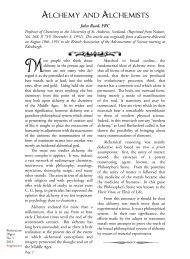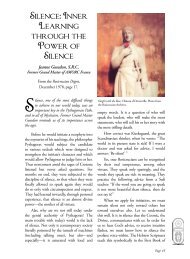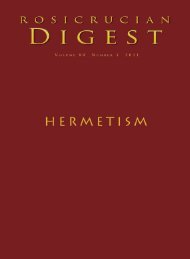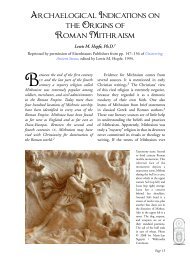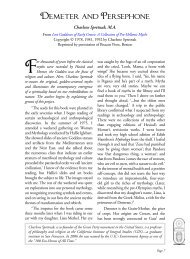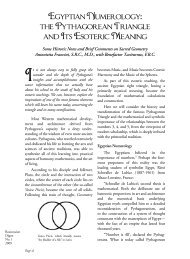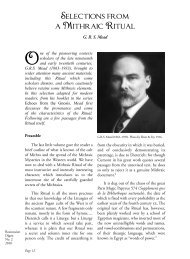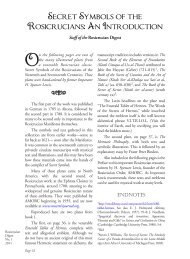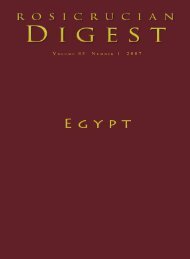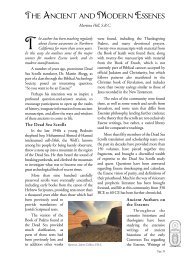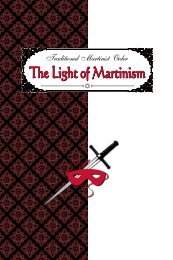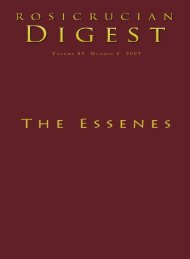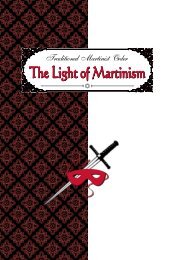The Grand Temple - Rosicrucian Order, AMORC
The Grand Temple - Rosicrucian Order, AMORC
The Grand Temple - Rosicrucian Order, AMORC
You also want an ePaper? Increase the reach of your titles
YUMPU automatically turns print PDFs into web optimized ePapers that Google loves.
<strong>Rosicrucian</strong>s, if democracy remains the best<br />
form of government, “the ideal in this regard<br />
would be for each nation to help promote the<br />
emergence of a government bringing together<br />
the personalities most capable of governing the<br />
affairs of state.” We also note throughout the<br />
Positio a desire to reaffirm the humanism distinctive<br />
to <strong>Rosicrucian</strong>s. Thus we read: “. . . each<br />
human being is an elementary cell of a single<br />
body that of all humanity. By virtue of this<br />
principle, our conception of humanism is that<br />
all humans should have the same rights, be given<br />
the same respect, and enjoy the same freedoms,<br />
regardless of the country of their origin or the<br />
nation in which they live.”<br />
In another realm, that of spirituality,<br />
<strong>AMORC</strong> ponders in the Positio the fate of the<br />
great religions, and even lets<br />
it be understood that they are<br />
fated to disappear in favor of<br />
a universal religion. For what<br />
is properly called <strong>Rosicrucian</strong><br />
spirituality, the fourth manifesto<br />
defines it in this way:<br />
“. . . it is based, on the one<br />
hand, upon the conviction<br />
that God exists as an Absolute<br />
Intelligence having created<br />
the universe and everything<br />
therein; and, on the other<br />
hand, on the assurance that<br />
each human being possesses<br />
a soul which emanates from<br />
God. Moreover, we think that<br />
God manifests in all Creation<br />
through laws that we must<br />
study, understand, and respect for our greater<br />
good.” While this spiritualistic humanism may<br />
seem utopian, it is precisely what <strong>AMORC</strong> calls<br />
for, recalling that Plato, in the Republic, sees the<br />
form of ideal society in Utopia. Under these<br />
conditions, it is not surprising that the Positio<br />
ends with a text deliberately given the title of<br />
“<strong>Rosicrucian</strong> Utopia,” placed under the auspices<br />
of “God of all beings, God of all life.”<br />
<strong>The</strong> Positio Fraternitatis Rosae Crucis continues<br />
the lineage of the <strong>Rosicrucian</strong> manifestos<br />
published in the 17th century. We may even<br />
say that it constitutes their continuation beyond<br />
time and space. As such, it now forms an integral<br />
part of the <strong>Rosicrucian</strong> Tradition and builds<br />
a bridge between the <strong>Rosicrucian</strong>s of yesteryear<br />
and those of today. Furthermore, since its publication<br />
this fourth manifesto has been the object<br />
One of <strong>AMORC</strong>’s official symbols, with the <strong>Order</strong>’s<br />
name in Latin. Among <strong>Rosicrucian</strong>s, the cross<br />
represents the human physical body and the rose<br />
represents the human soul on the path of evolution.<br />
of comments along these lines, on the part of<br />
historians of esotericism. Let us mention one in<br />
particular: Antoine Faivre, who has written, “It<br />
will certainly remain as an outstanding document<br />
in the history of <strong>Rosicrucian</strong>ism.”<br />
In concluding this series of articles, and<br />
after having followed in the steps of Hermes<br />
Trismegistus and Christian Rosenkreuz, we are<br />
fully aware that this work does not constitute<br />
an exhaustive study of <strong>Rosicrucian</strong>ism. Faithful<br />
to our initial plan, we have striven, first of<br />
all, to place <strong>Rosicrucian</strong>ism in the history of<br />
esotericism. Thus, by traveling from ancient<br />
Egypt to the modern day world, we have seen<br />
how Western esotericism has developed over<br />
the centuries. It may also be<br />
noted that in most eras Egypt<br />
has been perceived as the<br />
historical or mythical center<br />
of a mysterious primordial<br />
Tradition that initiates have<br />
endeavored to hand down<br />
from one generation to another.<br />
Secondly, we have discussed<br />
the emergence of one<br />
of the most important presentday<br />
<strong>Rosicrucian</strong> movements:<br />
the Ancient and Mystical<br />
<strong>Order</strong> Rosae Crucis. We have<br />
not attempted to deal with<br />
all of its history, but we have<br />
chosen to present the essential<br />
stages. After nearly a century of<br />
existence, <strong>AMORC</strong> has kept<br />
alive the flame of <strong>Rosicrucian</strong>ism by adapting it<br />
to the modern world, promoting a teaching that<br />
relinquishes occultism in favor of the personal<br />
and spiritual unfoldment of its members.<br />
As this study has shown, many individuals<br />
have worked to establish <strong>Rosicrucian</strong>ism over<br />
the centuries. When attempting to wed the Rose<br />
and the Cross, some of them were wounded by<br />
the thorns that protect the flower of the soul, as<br />
they are not perfect sages, but rather men and<br />
women with all of their human qualities and<br />
flaws. Nevertheless, each person has, to one<br />
degree or another, contributed to the elevation of<br />
humanity, by encouraging his or her contemporaries<br />
to look beyond the world of appearances,<br />
so that they could discover therein the presence<br />
of the Divine. And, in so doing, the questions<br />
that they have raised concerning the mysteries of<br />
Page 31




